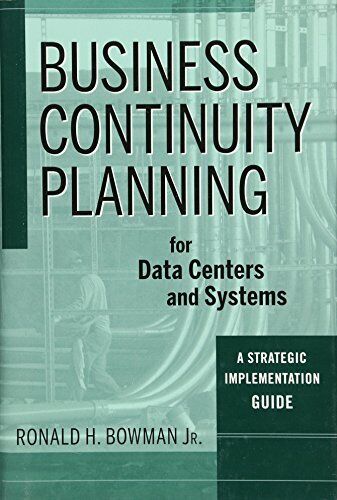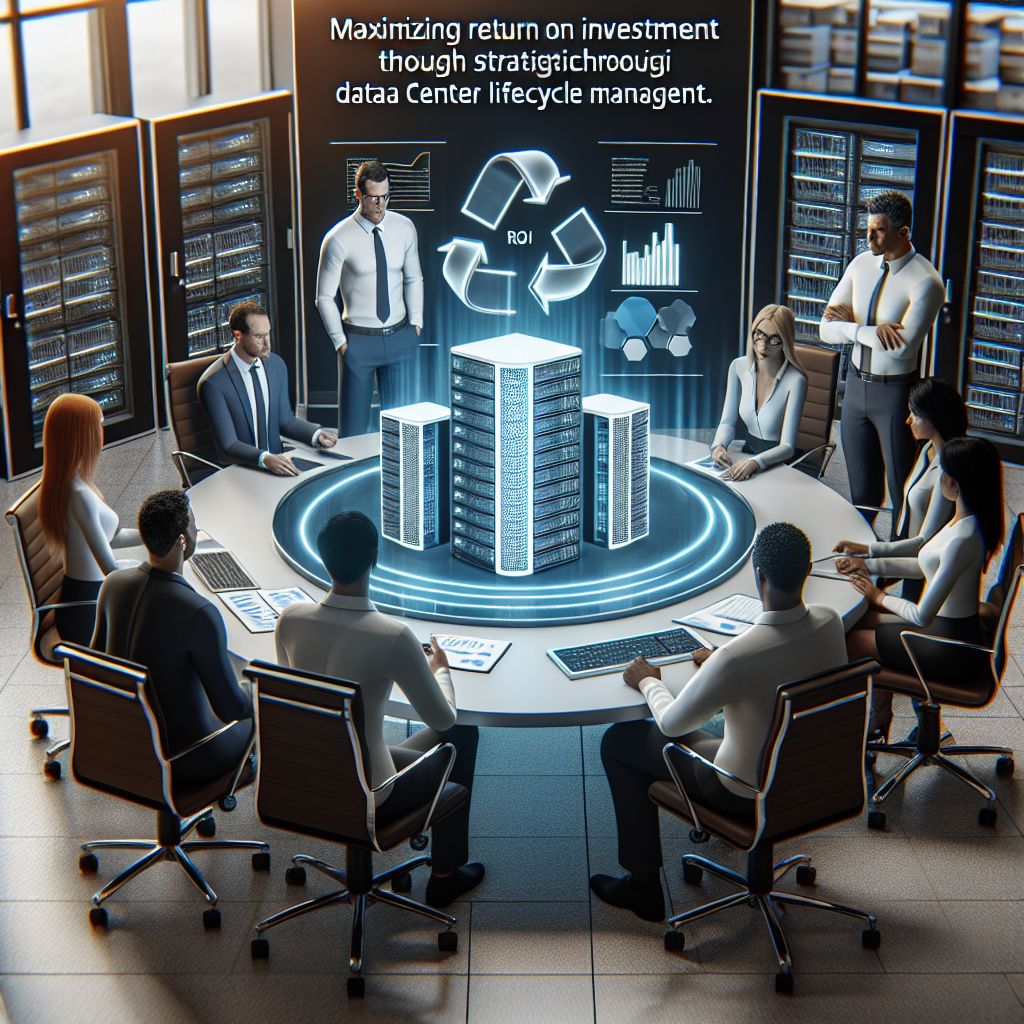Your cart is currently empty!
Tag: Strategic

Creating a Strategic Plan for Data Center Facilities Management
In today’s digital age, data centers have become the backbone of every organization’s IT infrastructure. These facilities house and manage critical data and applications, ensuring that businesses can operate efficiently and effectively. However, managing a data center facility is no easy task. From ensuring optimal performance and reliability to maintaining security and compliance, there are a multitude of factors that must be considered to keep a data center running smoothly.One key aspect of effectively managing a data center facility is creating a strategic plan. A strategic plan outlines the goals and objectives of the data center, as well as the strategies and tactics that will be used to achieve them. By creating a strategic plan for data center facilities management, organizations can ensure that their data centers operate at peak performance and are able to meet the evolving needs of the business.
When creating a strategic plan for data center facilities management, there are several key steps that organizations should take. First and foremost, it is important to assess the current state of the data center facility. This includes evaluating the physical infrastructure, such as power and cooling systems, as well as the operational processes and procedures in place. By understanding the current state of the data center, organizations can identify areas for improvement and develop a plan to address them.
Next, organizations should define their goals and objectives for the data center facility. This may include improving uptime and reliability, increasing energy efficiency, or enhancing security measures. By clearly outlining these goals, organizations can ensure that their strategic plan is focused and aligned with the overall objectives of the business.
Once goals have been established, organizations should develop strategies and tactics to achieve them. This may include implementing new technologies, upgrading infrastructure, or improving operational processes. It is important to consider the potential impact of these strategies on the data center facility, as well as the resources and budget required to implement them.
In addition to outlining strategies and tactics, organizations should also establish key performance indicators (KPIs) to measure the success of their strategic plan. These KPIs may include metrics such as uptime, energy efficiency, and security compliance. By regularly monitoring and evaluating these KPIs, organizations can ensure that their data center is operating as effectively and efficiently as possible.
Finally, it is important to regularly review and update the strategic plan for data center facilities management. As technology and business needs evolve, organizations must be able to adapt their strategies and tactics to meet these changes. By regularly reviewing and updating the strategic plan, organizations can ensure that their data center remains a valuable asset to the business.
In conclusion, creating a strategic plan for data center facilities management is essential for ensuring the success and effectiveness of a data center facility. By assessing the current state of the data center, defining goals and objectives, developing strategies and tactics, and establishing KPIs, organizations can ensure that their data center operates at peak performance and meets the evolving needs of the business. By regularly reviewing and updating the strategic plan, organizations can ensure that their data center remains a valuable asset to the business for years to come.

Business Continuity Planning for Data Centers and Systems: A Strategic Imple…

Business Continuity Planning for Data Centers and Systems: A Strategic Imple…
Price : 47.50
Ends on : N/A
View on eBay
mentation GuideIn today’s digital age, data centers and systems are at the core of most businesses’ operations. Ensuring their continuous and uninterrupted operation is crucial for business success. This is where Business Continuity Planning (BCP) comes into play.
BCP is the process of creating a plan to ensure that a company’s critical functions can continue to operate in the event of a disaster or other disruptive event. When it comes to data centers and systems, having a robust BCP in place is essential to minimize downtime, prevent data loss, and maintain business operations.
In this post, we will provide a strategic implementation guide for creating a Business Continuity Plan for data centers and systems:
1. Identify critical systems and data: The first step in creating a BCP for data centers and systems is to identify the critical systems and data that are essential for the business operations. This includes identifying key applications, databases, servers, and other infrastructure components that must be protected.
2. Conduct a risk assessment: Once you have identified the critical systems and data, you need to conduct a thorough risk assessment to identify potential threats and vulnerabilities that could impact your data center and systems. This includes natural disasters, cyber attacks, power outages, hardware failures, and other potential risks.
3. Develop a BCP strategy: Based on the risk assessment, develop a BCP strategy that outlines how you will protect and recover your data center and systems in the event of a disaster. This includes defining recovery time objectives (RTOs) and recovery point objectives (RPOs), identifying backup and recovery solutions, and establishing communication and notification protocols.
4. Test and refine the BCP: Once you have developed your BCP strategy, it’s important to test it regularly to ensure that it will work effectively in a real-world scenario. This includes conducting tabletop exercises, simulations, and drills to identify any gaps or weaknesses in the plan and refine it accordingly.
5. Train and educate staff: Finally, make sure that your staff are trained and educated on the BCP and understand their roles and responsibilities in the event of a disaster. This includes providing training on how to use backup and recovery solutions, how to communicate during a crisis, and how to execute the BCP effectively.
By following these steps and implementing a comprehensive BCP for your data centers and systems, you can ensure that your business operations remain resilient and continue to thrive in the face of any potential disruptions. Remember, business continuity is not just a plan, it’s a mindset that should be ingrained in your organization’s culture.
#Business #Continuity #Planning #Data #Centers #Systems #Strategic #Imple..
Streamlining Data Center Operations with Strategic Cabling Solutions
In today’s fast-paced business environment, data centers play a crucial role in ensuring the smooth operation of organizations. These facilities house critical IT equipment and infrastructure that support a wide range of functions, from storing and managing data to hosting applications and services. As such, it is essential for data center operators to optimize their operations and maximize efficiency to meet the growing demands of modern business.One key aspect of data center operations that can significantly impact efficiency is cabling infrastructure. The way data cables are installed and managed in a data center can have a profound effect on performance, reliability, and scalability. By implementing strategic cabling solutions, data center operators can streamline their operations and enhance overall productivity.
One of the primary benefits of strategic cabling solutions is improved organization and management of cables. Proper cable management not only reduces the risk of cable congestion and tangling but also makes it easier to identify and troubleshoot issues when they arise. This, in turn, can minimize downtime and improve the overall reliability of the data center.
Additionally, strategic cabling solutions can help optimize airflow within the data center, which is crucial for maintaining the proper operating temperature of IT equipment. By carefully planning the layout of cables and ensuring proper ventilation, data center operators can prevent hotspots and improve the overall efficiency of cooling systems.
Furthermore, strategic cabling solutions can also support the scalability and flexibility of data center operations. As organizations grow and evolve, they may need to add new equipment or upgrade existing infrastructure. By implementing a structured cabling system that is designed to accommodate future expansion, data center operators can easily make changes and additions without disrupting operations.
In conclusion, streamlining data center operations with strategic cabling solutions is essential for maximizing efficiency, reliability, and scalability. By investing in proper cable management, optimizing airflow, and planning for future growth, data center operators can ensure that their facilities are well-equipped to meet the demands of modern business. Ultimately, a well-designed cabling infrastructure is the foundation for a successful data center operation.

Improving Data Center Performance with Strategic Problem Management
In today’s digital age, data centers play a crucial role in ensuring smooth operations for businesses of all sizes. These facilities house servers, storage devices, networking equipment, and other critical infrastructure that store and process data. However, with the increasing complexity of IT environments and the growing volume of data being generated, data centers are facing challenges in terms of performance and efficiency.One of the key strategies for improving data center performance is strategic problem management. This approach involves identifying, analyzing, and resolving issues that are impacting the performance of the data center. By proactively addressing problems, organizations can prevent downtime, optimize resources, and enhance overall efficiency.
There are several ways in which strategic problem management can help improve data center performance:
1. Identify and prioritize issues: By implementing a structured approach to problem management, organizations can quickly identify and prioritize issues that are impacting the performance of the data center. This allows IT teams to focus their efforts on resolving the most critical issues first, minimizing downtime and disruption to operations.
2. Root cause analysis: Strategic problem management involves conducting root cause analysis to determine the underlying reasons for performance issues. By identifying the root cause of a problem, organizations can implement targeted solutions that address the issue at its source, rather than just treating the symptoms.
3. Proactive monitoring and alerting: Monitoring tools can help IT teams proactively identify potential issues before they escalate into major problems. By setting up alerts and notifications for key performance metrics, organizations can take action to address issues before they impact operations.
4. Continuous improvement: Strategic problem management is an ongoing process that involves continuously monitoring, analyzing, and improving data center performance. By regularly reviewing and updating problem management processes, organizations can ensure that their data center operations remain efficient and effective.
5. Collaboration and communication: Effective problem management requires collaboration and communication among IT teams, stakeholders, and vendors. By working together to identify and resolve issues, organizations can leverage the expertise and resources of all parties involved to improve data center performance.
In conclusion, strategic problem management is a critical component of improving data center performance. By implementing a structured approach to identifying, analyzing, and resolving issues, organizations can prevent downtime, optimize resources, and enhance overall efficiency. By prioritizing issues, conducting root cause analysis, proactively monitoring and alerting, and fostering collaboration and communication, organizations can ensure that their data center operations continue to meet the needs of their business in today’s fast-paced digital landscape.

The Importance of Strategic Data Center Lifecycle Management
In today’s digital age, data centers play a crucial role in storing, processing, and managing large amounts of data for businesses and organizations. With the increasing reliance on technology and the growing volume of data being generated, it has become more important than ever for companies to effectively manage their data center lifecycle.Strategic data center lifecycle management is essential for ensuring that a data center operates efficiently, effectively, and securely throughout its lifespan. This involves planning, implementing, and maintaining processes and procedures to optimize the performance, reliability, and cost-effectiveness of a data center.
One of the key benefits of strategic data center lifecycle management is cost savings. By carefully planning and managing the lifecycle of a data center, companies can avoid unnecessary expenses, such as downtime, maintenance, and upgrades. This can help organizations reduce their overall operating costs and improve their bottom line.
Another important aspect of strategic data center lifecycle management is risk management. Data centers are vulnerable to a wide range of risks, including security breaches, natural disasters, and equipment failures. By implementing robust lifecycle management practices, companies can mitigate these risks and ensure the continuity of their operations.
Additionally, strategic data center lifecycle management can help organizations adapt to changing business needs and technological advancements. As businesses evolve and grow, their data center requirements may change. By continually assessing and optimizing their data center lifecycle, companies can ensure that their data center infrastructure remains aligned with their business goals and objectives.
Ultimately, strategic data center lifecycle management is crucial for ensuring the long-term success and sustainability of a data center. By proactively managing the lifecycle of a data center, companies can optimize performance, reduce costs, mitigate risks, and adapt to changing business needs. This can help organizations stay competitive in today’s fast-paced and data-driven business environment.

Maximizing ROI Through Strategic Vendor Management in Data Centers
In today’s digital age, data centers play a crucial role in the operations of businesses of all sizes. These facilities house the servers and equipment necessary for storing, processing, and managing vast amounts of data. With the increasing reliance on data centers, maximizing return on investment (ROI) through strategic vendor management has become essential for businesses looking to optimize their operations and reduce costs.Vendor management in data centers involves working closely with suppliers and service providers to ensure that the needs of the business are met efficiently and cost-effectively. By strategically managing vendors, businesses can minimize risks, improve service levels, and ultimately maximize ROI.
One key aspect of strategic vendor management in data centers is negotiating favorable contracts with suppliers. By carefully reviewing and negotiating service level agreements (SLAs) and pricing terms, businesses can ensure that they are getting the best value for their money. This includes negotiating for discounts, incentives, and flexible contract terms that align with the business’s needs and budget.
Another important aspect of vendor management is monitoring and evaluating vendor performance. By regularly assessing key performance indicators (KPIs) such as uptime, response times, and customer satisfaction, businesses can identify areas for improvement and hold vendors accountable for meeting their obligations. This ensures that the business is getting the best possible service from its vendors and can make informed decisions about renewing or renegotiating contracts.
In addition to negotiating contracts and monitoring performance, businesses can also maximize ROI through strategic vendor management by optimizing resource utilization. By working closely with vendors to right-size capacity and reduce waste, businesses can lower costs and improve efficiency. This includes implementing technologies such as virtualization and cloud computing to maximize the use of resources and reduce the need for physical infrastructure.
Furthermore, businesses can also benefit from strategic vendor management by leveraging vendor expertise and innovation. By collaborating with vendors on technology roadmaps and strategic initiatives, businesses can stay ahead of the curve and take advantage of new technologies and trends. This can lead to increased efficiency, improved performance, and a competitive edge in the market.
In conclusion, maximizing ROI through strategic vendor management in data centers is essential for businesses looking to optimize their operations and reduce costs. By negotiating favorable contracts, monitoring vendor performance, optimizing resource utilization, and leveraging vendor expertise, businesses can ensure that they are getting the best value for their money and staying competitive in the digital age. By investing time and resources into strategic vendor management, businesses can achieve long-term success and growth in the ever-changing world of data centers.

Maximizing Performance with Strategic Data Center Power Distribution
In today’s digital age, data centers play a crucial role in ensuring the smooth operation of businesses and organizations. These facilities are responsible for storing, processing, and distributing vast amounts of data that are essential for day-to-day operations. As such, it is imperative for data centers to maximize performance and efficiency to meet the growing demands of users and customers.One key aspect of data center operations that significantly impacts performance is power distribution. Data centers consume large amounts of electricity to power servers, cooling systems, and other equipment. Therefore, having a strategic power distribution plan in place is essential to ensure optimal performance and reliability.
There are several ways data centers can maximize performance with strategic power distribution. One of the most important aspects is ensuring redundancy and reliability in power distribution systems. Redundant power sources, backup generators, and uninterruptible power supply (UPS) systems are critical components that ensure continuous power supply to data center equipment, even in the event of a power outage.
Another important factor in maximizing performance is energy efficiency. Data centers are notorious for their high energy consumption, so implementing energy-efficient power distribution systems can significantly reduce operating costs and environmental impact. This can be achieved by using energy-efficient power distribution units (PDUs), implementing hot aisle/cold aisle containment, and utilizing power management software to optimize energy usage.
Furthermore, data centers can also benefit from implementing intelligent power distribution systems that provide real-time monitoring and control of power consumption. By having a comprehensive view of power usage and distribution, data center operators can identify potential issues and optimize power distribution to maximize performance and efficiency.
In conclusion, maximizing performance with strategic data center power distribution is essential for ensuring the smooth operation of data centers. By implementing redundant and reliable power distribution systems, optimizing energy efficiency, and utilizing intelligent power management solutions, data centers can enhance performance, reduce costs, and improve overall reliability. Ultimately, a well-planned power distribution strategy is essential for meeting the growing demands of today’s data-driven world.

Mitigating Risks through Strategic Data Center Change Management
In today’s fast-paced business environment, data centers play a crucial role in ensuring the seamless operation of critical IT infrastructure. However, with the increasing complexity of technology and the growing volume of data being processed, data center change management has become a critical concern for organizations looking to mitigate risks and ensure the continuity of their operations.Change management refers to the process of planning, implementing, and managing changes to IT systems and infrastructure in a structured and controlled manner. It involves assessing the impact of changes, managing potential risks, and ensuring that changes are implemented smoothly and efficiently.
Mitigating risks through strategic data center change management is essential for organizations looking to minimize downtime, ensure data security, and protect the integrity of their infrastructure. By implementing a robust change management process, organizations can proactively identify and address potential risks, plan for contingencies, and minimize the impact of changes on their operations.
One of the key benefits of strategic data center change management is the ability to anticipate and mitigate potential risks before they escalate into major problems. By conducting thorough risk assessments and impact analyses prior to implementing changes, organizations can identify potential issues and develop strategies to address them effectively. This proactive approach helps to minimize the likelihood of unexpected downtime, data loss, or security breaches.
Another important aspect of strategic data center change management is the establishment of clear communication channels and stakeholder involvement. By involving key stakeholders in the change management process, organizations can ensure that changes are aligned with business objectives, address critical concerns, and receive the necessary support and resources for successful implementation. Effective communication also helps to manage expectations, build trust, and foster collaboration among all parties involved in the change management process.
Furthermore, strategic data center change management involves the use of tools and technologies to automate and streamline the change management process. By leveraging automation tools, organizations can reduce human error, increase efficiency, and ensure consistency in the implementation of changes. Automation also enables organizations to track and monitor changes in real-time, identify potential issues, and take corrective actions promptly.
In conclusion, mitigating risks through strategic data center change management is essential for organizations looking to ensure the resilience and reliability of their IT infrastructure. By implementing a structured and proactive approach to change management, organizations can identify and address potential risks, minimize downtime, and ensure the continuity of their operations. With the increasing complexity of technology and the growing volume of data being processed, strategic data center change management is a critical component of any organization’s IT strategy.

Maximizing ROI with Strategic Data Center Lifecycle Management
In today’s digital age, data centers play a critical role in the success of businesses across various industries. These facilities house the servers and networking equipment that store and process vast amounts of data, enabling organizations to operate efficiently and effectively. However, data centers also come with significant costs, both in terms of capital investment and ongoing operational expenses. To maximize the return on investment (ROI) of a data center, organizations must implement strategic data center lifecycle management practices.Data center lifecycle management involves the planning, design, construction, operation, and maintenance of a data center throughout its lifespan. By taking a proactive and strategic approach to managing their data centers, organizations can optimize performance, reduce costs, and ensure the longevity of their facilities. Here are some key strategies for maximizing ROI with strategic data center lifecycle management:
1. Conduct Regular Assessments: Regular assessments of the data center infrastructure are essential for identifying potential issues and areas for improvement. By conducting periodic assessments, organizations can proactively address issues such as outdated equipment, inefficient cooling systems, and inadequate power distribution. This can help to optimize performance, increase energy efficiency, and reduce operational costs.
2. Implement Energy-Efficient Technologies: Energy consumption is a significant cost driver for data centers, accounting for a large portion of their operational expenses. By implementing energy-efficient technologies such as virtualization, server consolidation, and advanced cooling systems, organizations can reduce their energy consumption and lower their utility bills. Additionally, energy-efficient technologies can help to prolong the lifespan of equipment and reduce the risk of downtime.
3. Optimize Capacity Planning: Proper capacity planning is essential for ensuring that the data center has enough resources to meet current and future demands. By analyzing data usage patterns and forecasting future growth, organizations can optimize capacity planning to avoid overprovisioning or underprovisioning resources. This can help to maximize the efficiency of the data center and avoid unnecessary expenses.
4. Implement Robust Security Measures: Data security is a top priority for organizations, especially in today’s increasingly digital world. By implementing robust security measures such as firewalls, intrusion detection systems, and access controls, organizations can protect their data and prevent costly security breaches. Additionally, regular security audits and assessments can help to identify vulnerabilities and address them before they are exploited by malicious actors.
5. Implement Disaster Recovery and Business Continuity Plans: Data centers are vulnerable to various risks, including natural disasters, power outages, and equipment failures. To minimize the impact of these risks, organizations should implement robust disaster recovery and business continuity plans. These plans should outline procedures for backing up data, restoring services, and resuming operations in the event of a disaster. By proactively planning for potential disruptions, organizations can minimize downtime and protect their bottom line.
In conclusion, strategic data center lifecycle management is essential for maximizing ROI and ensuring the long-term success of an organization’s data center operations. By implementing proactive strategies such as regular assessments, energy-efficient technologies, optimized capacity planning, robust security measures, and disaster recovery plans, organizations can optimize performance, reduce costs, and protect their data assets. By taking a strategic approach to managing their data centers, organizations can maximize the value of their investments and stay competitive in today’s digital landscape.


